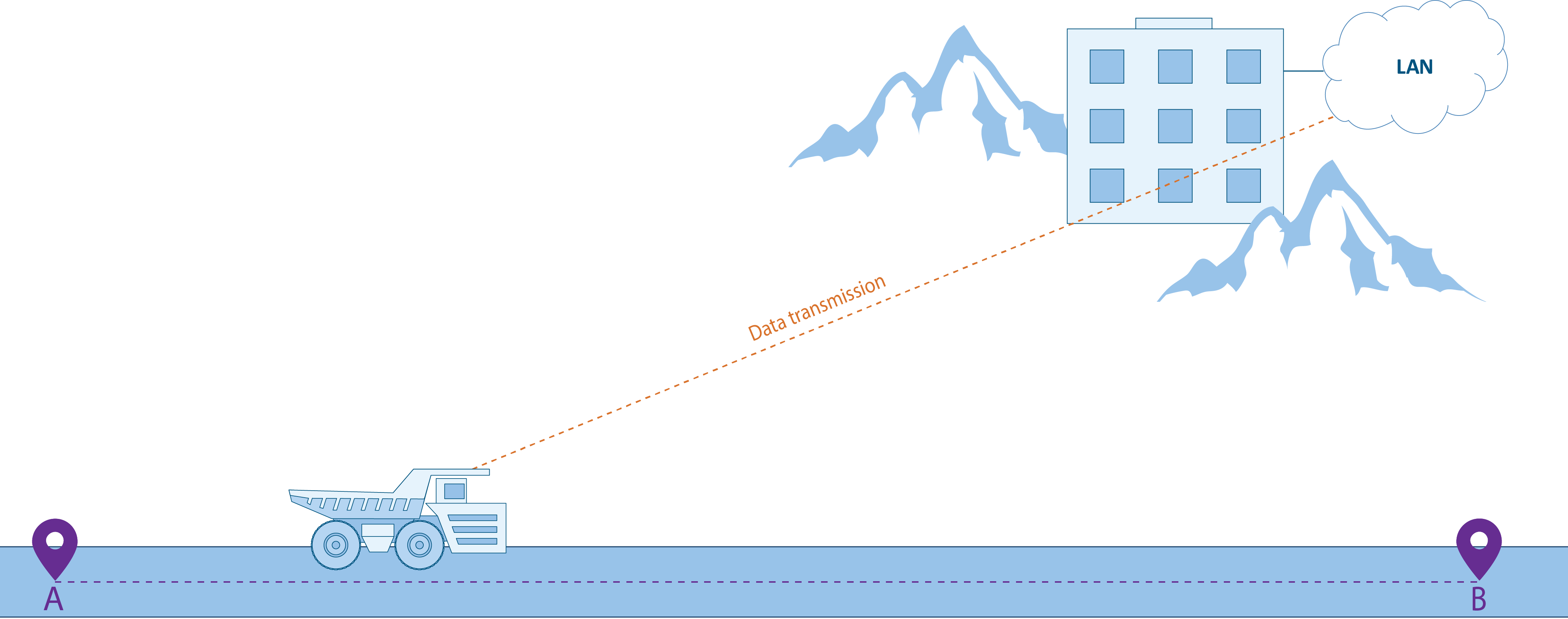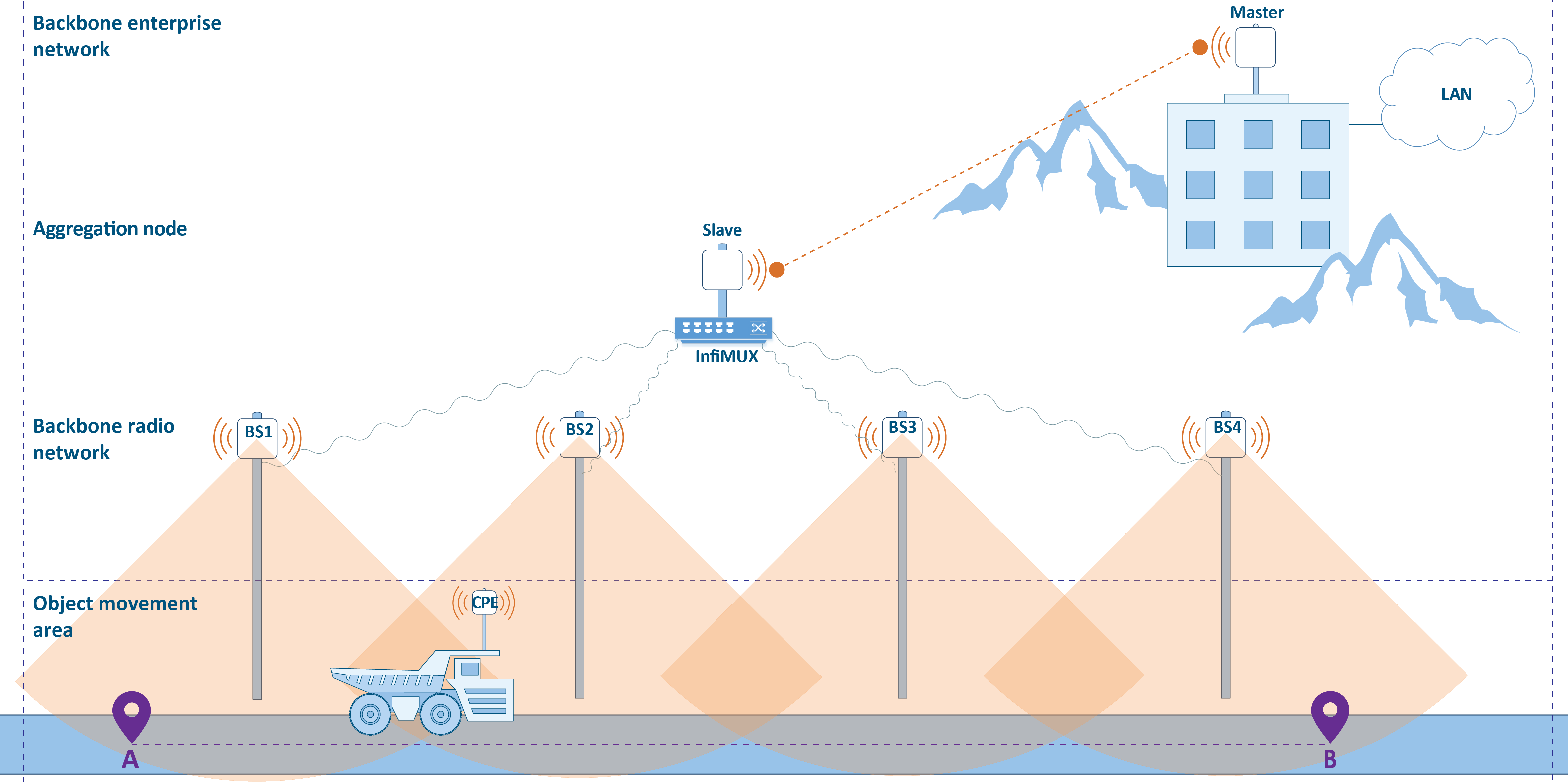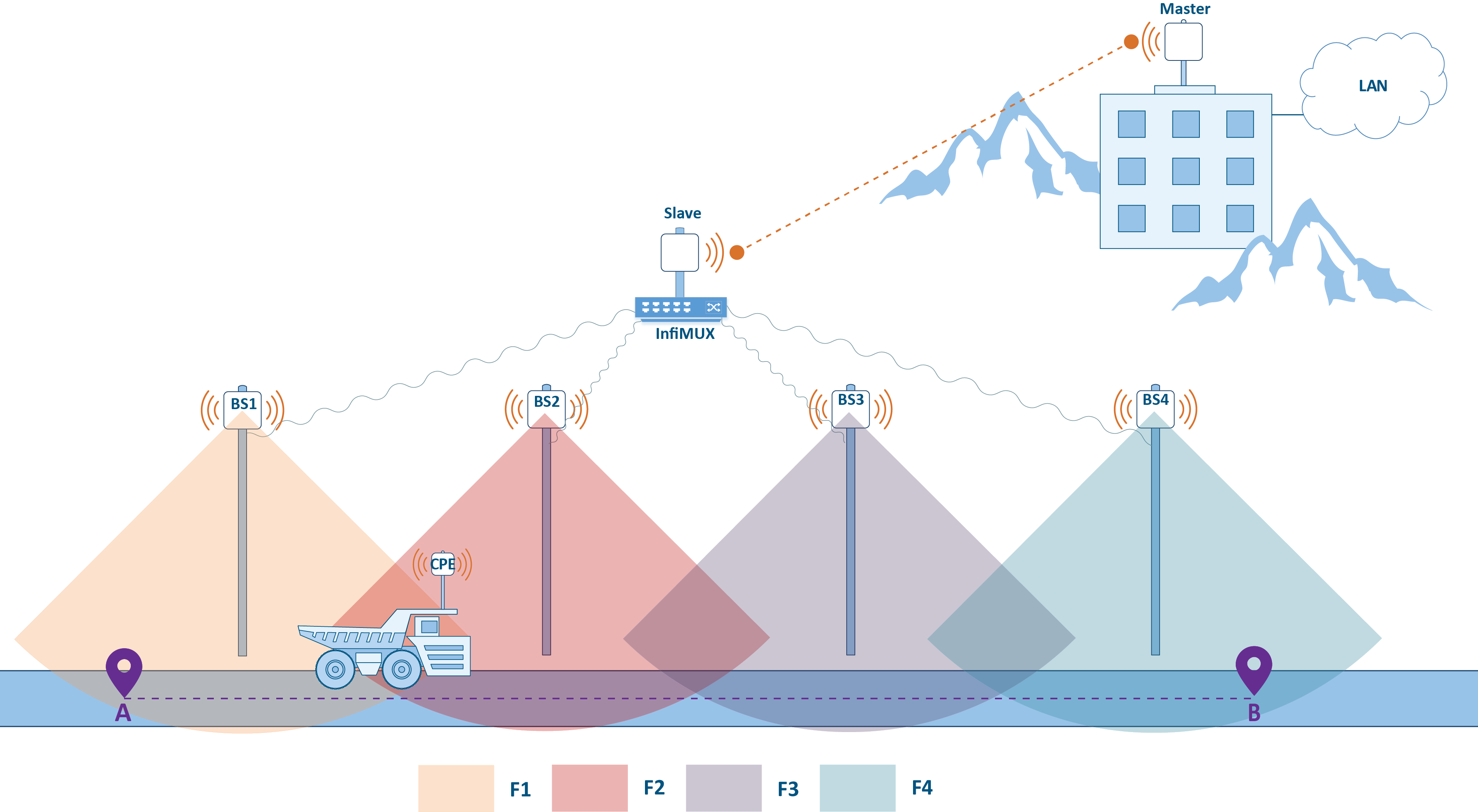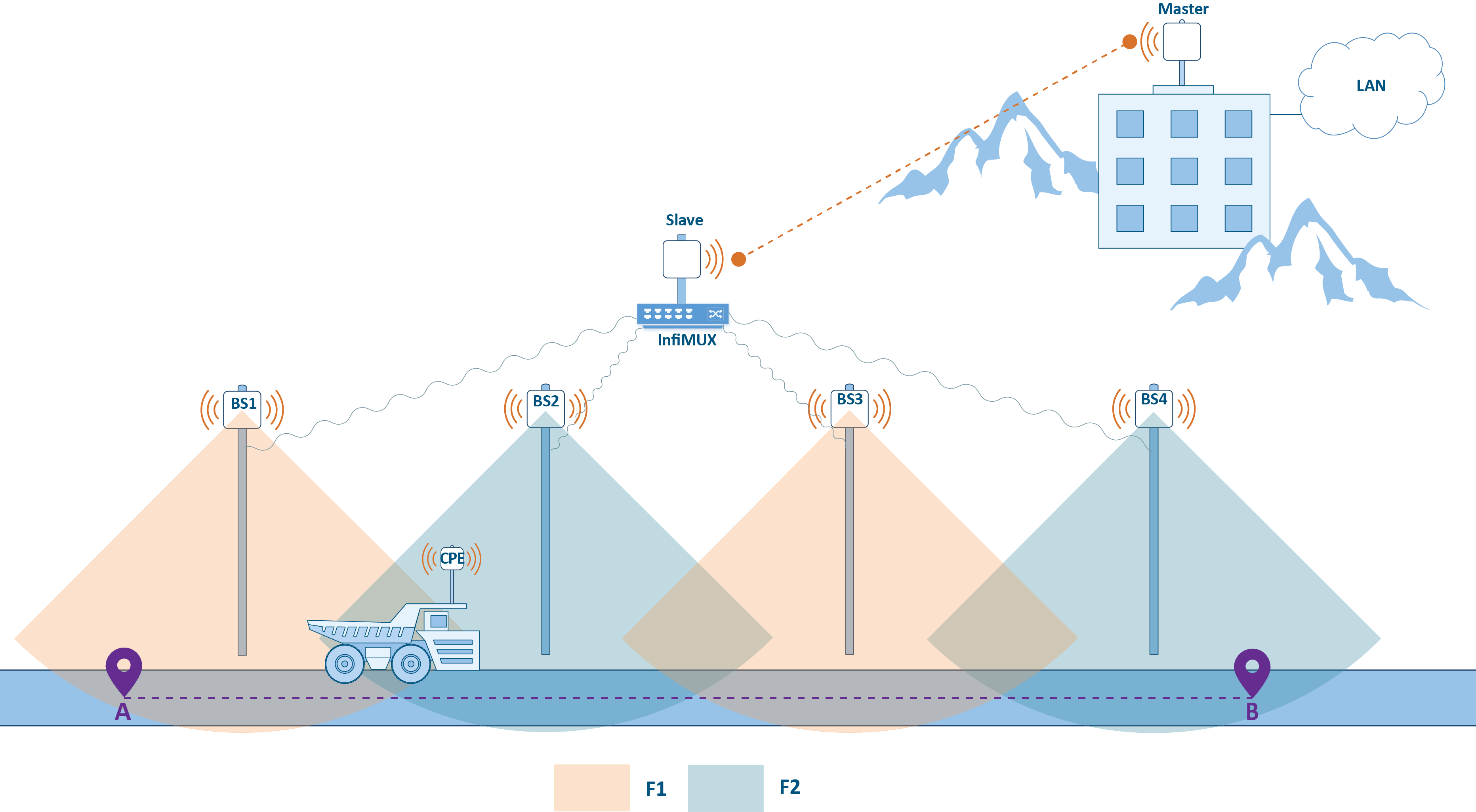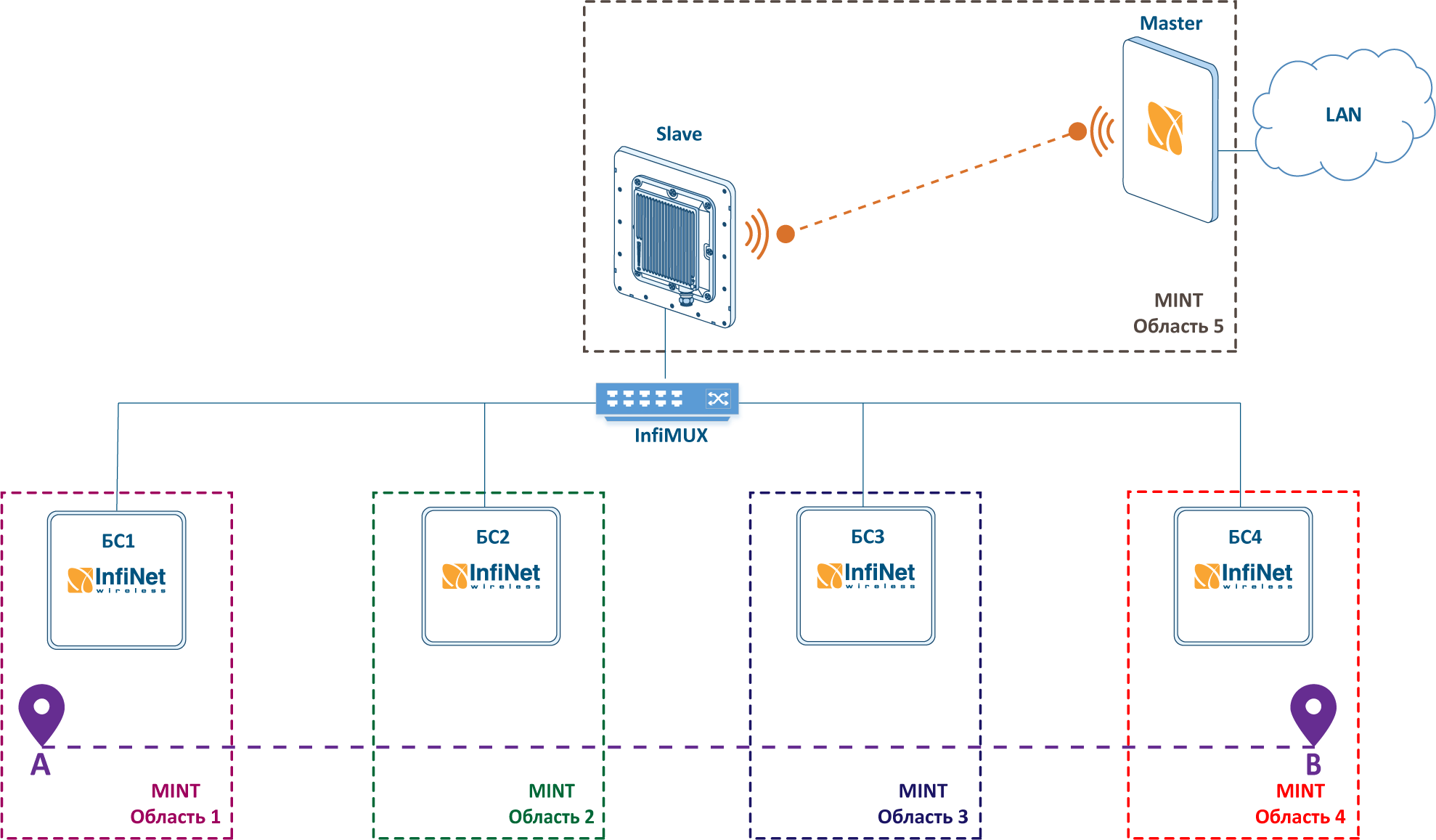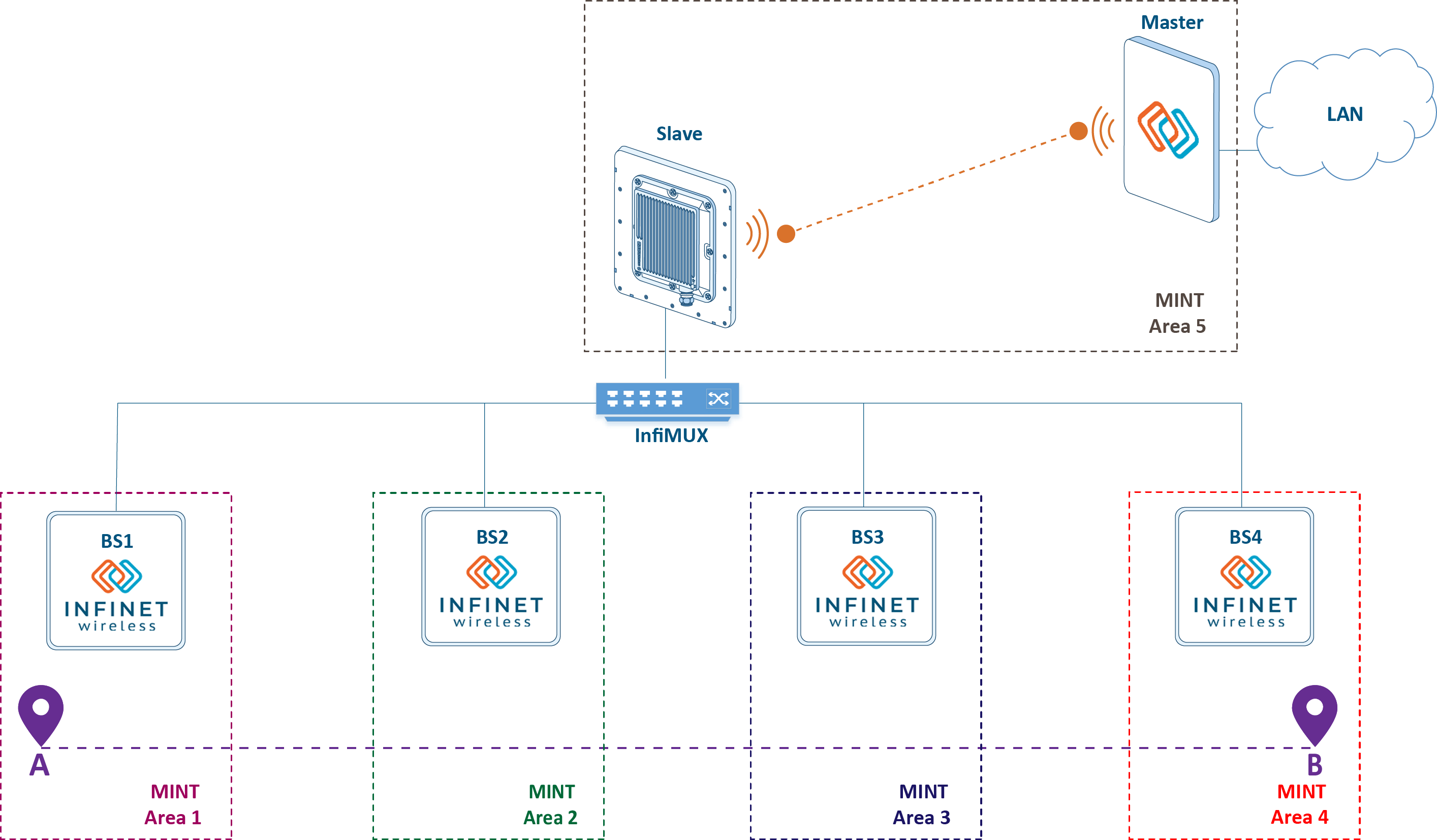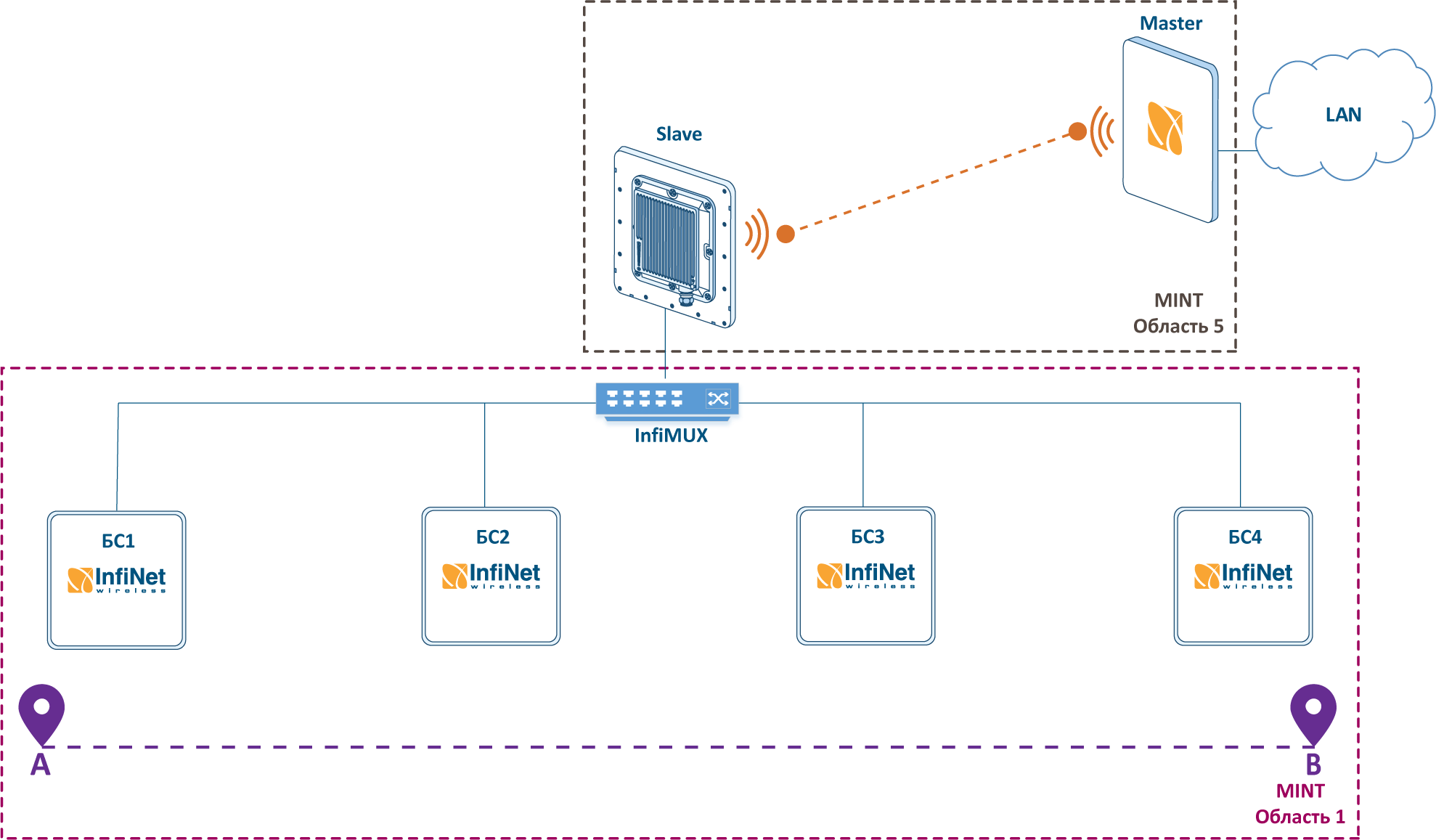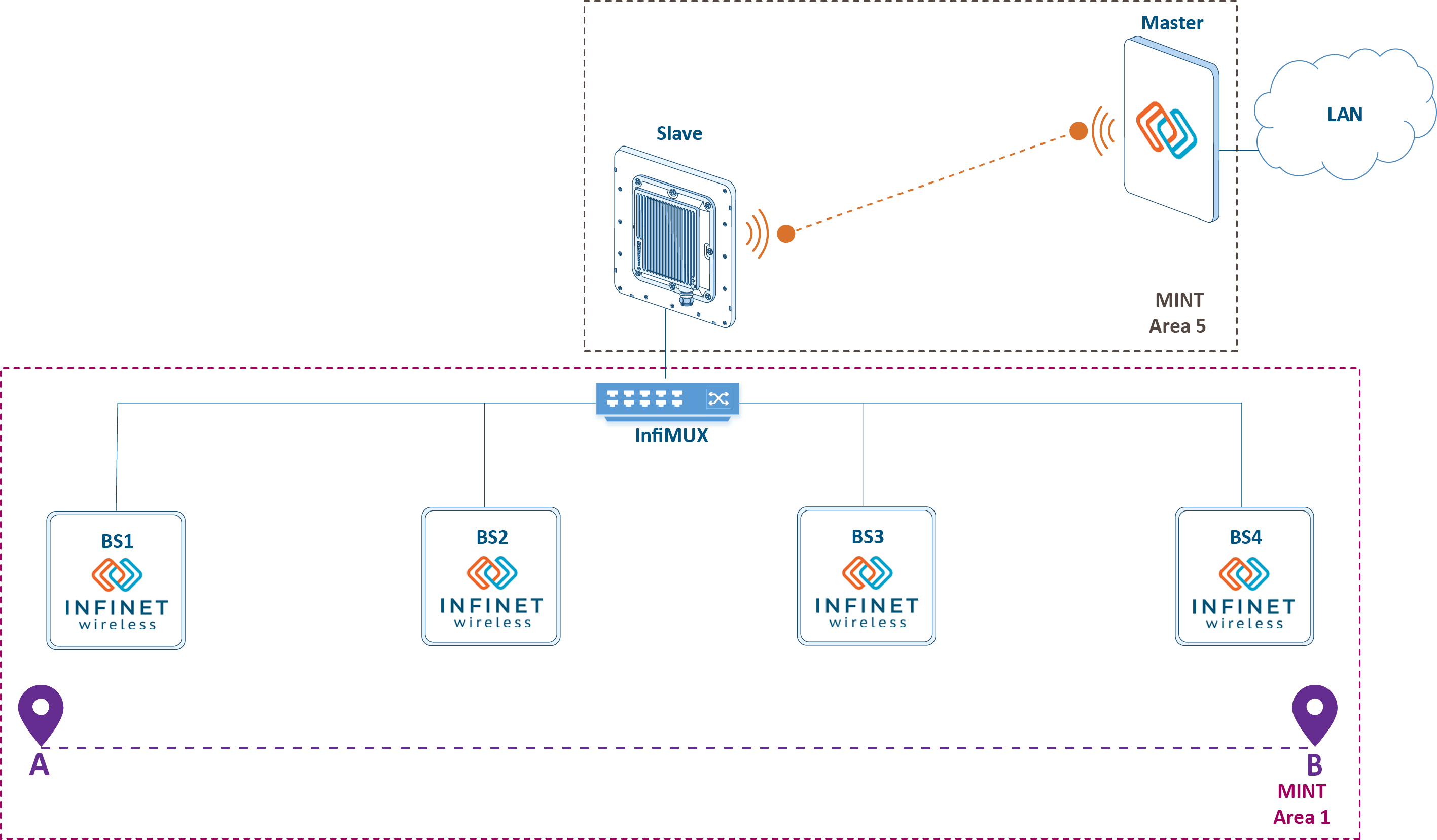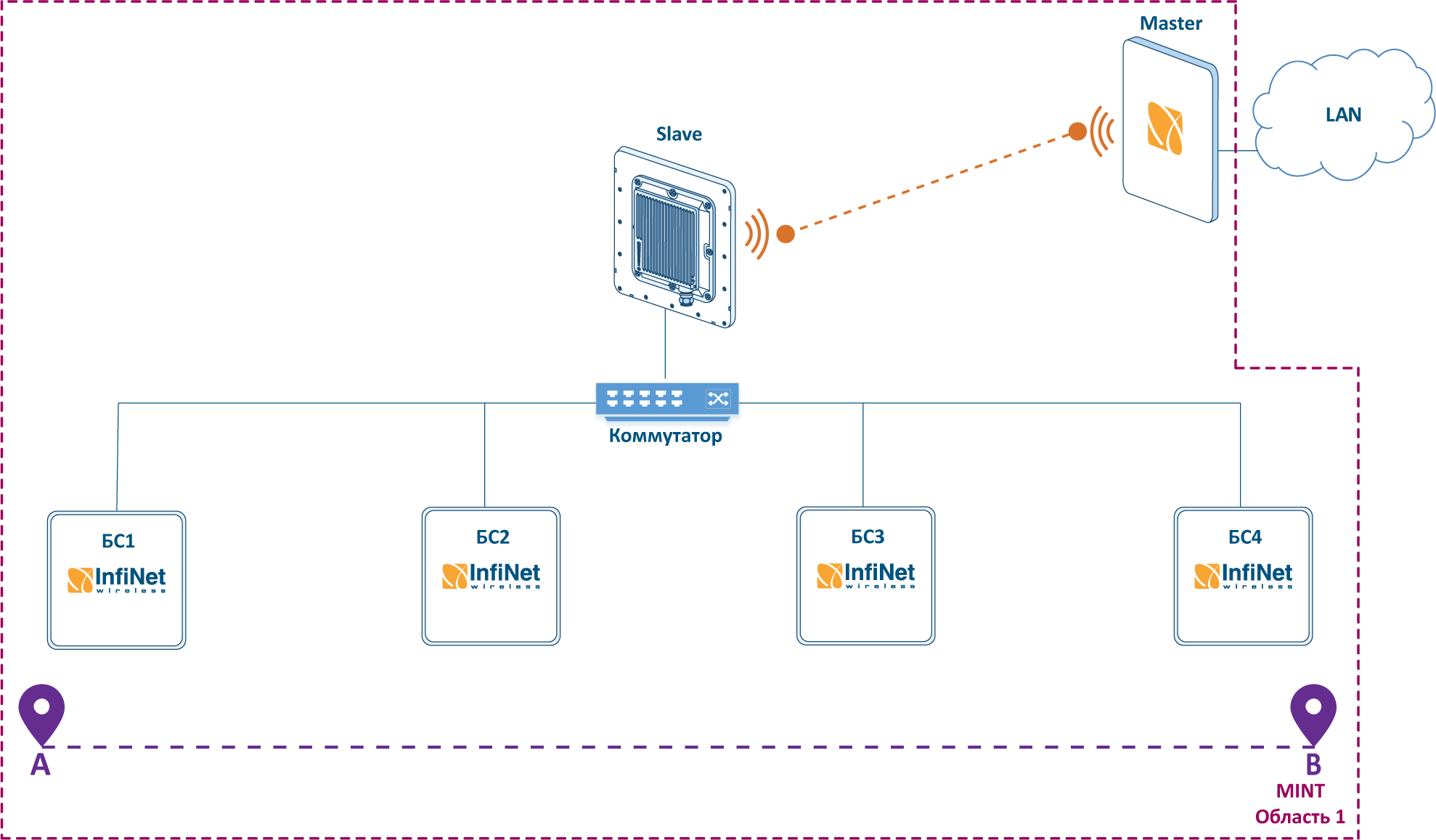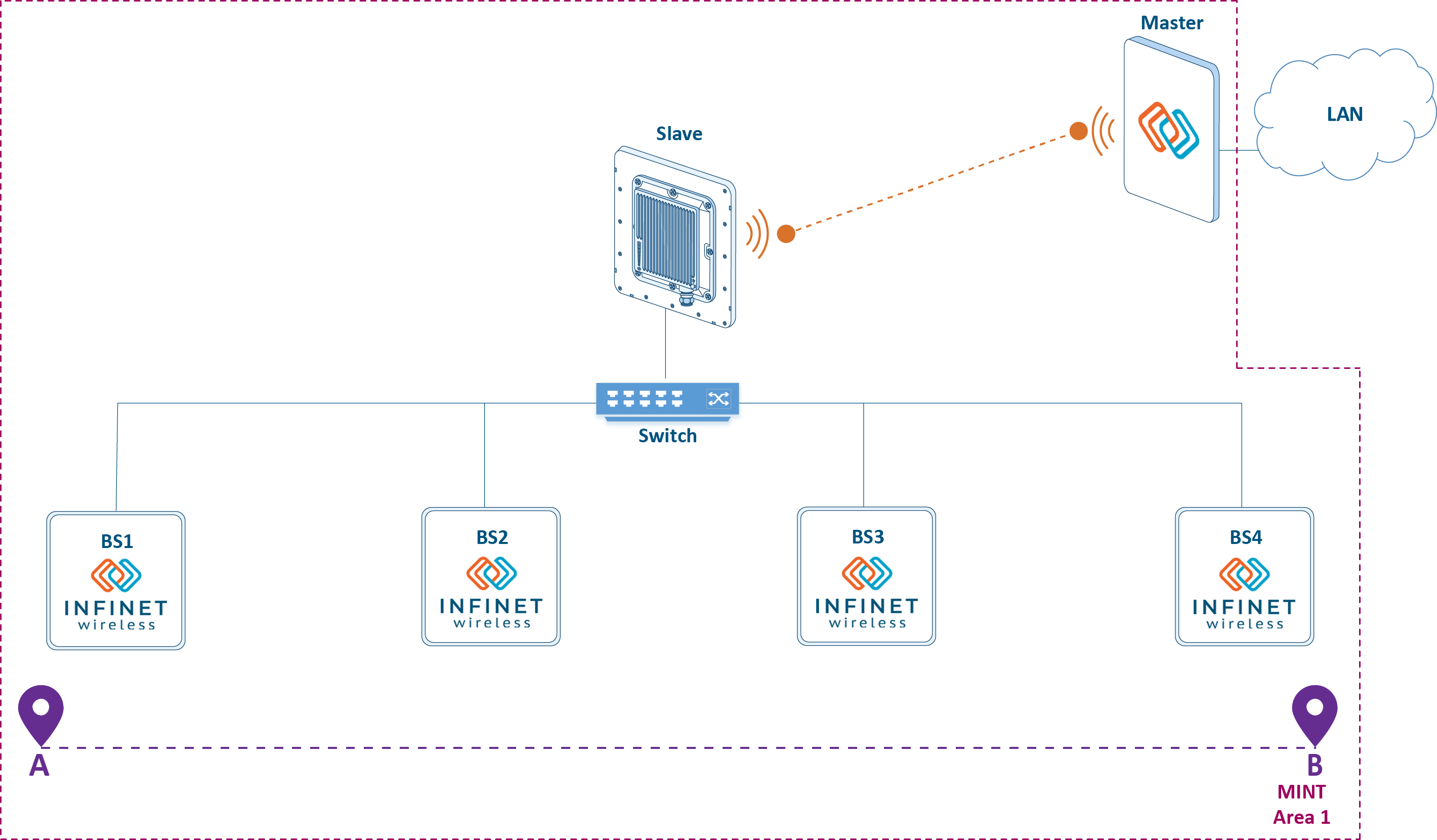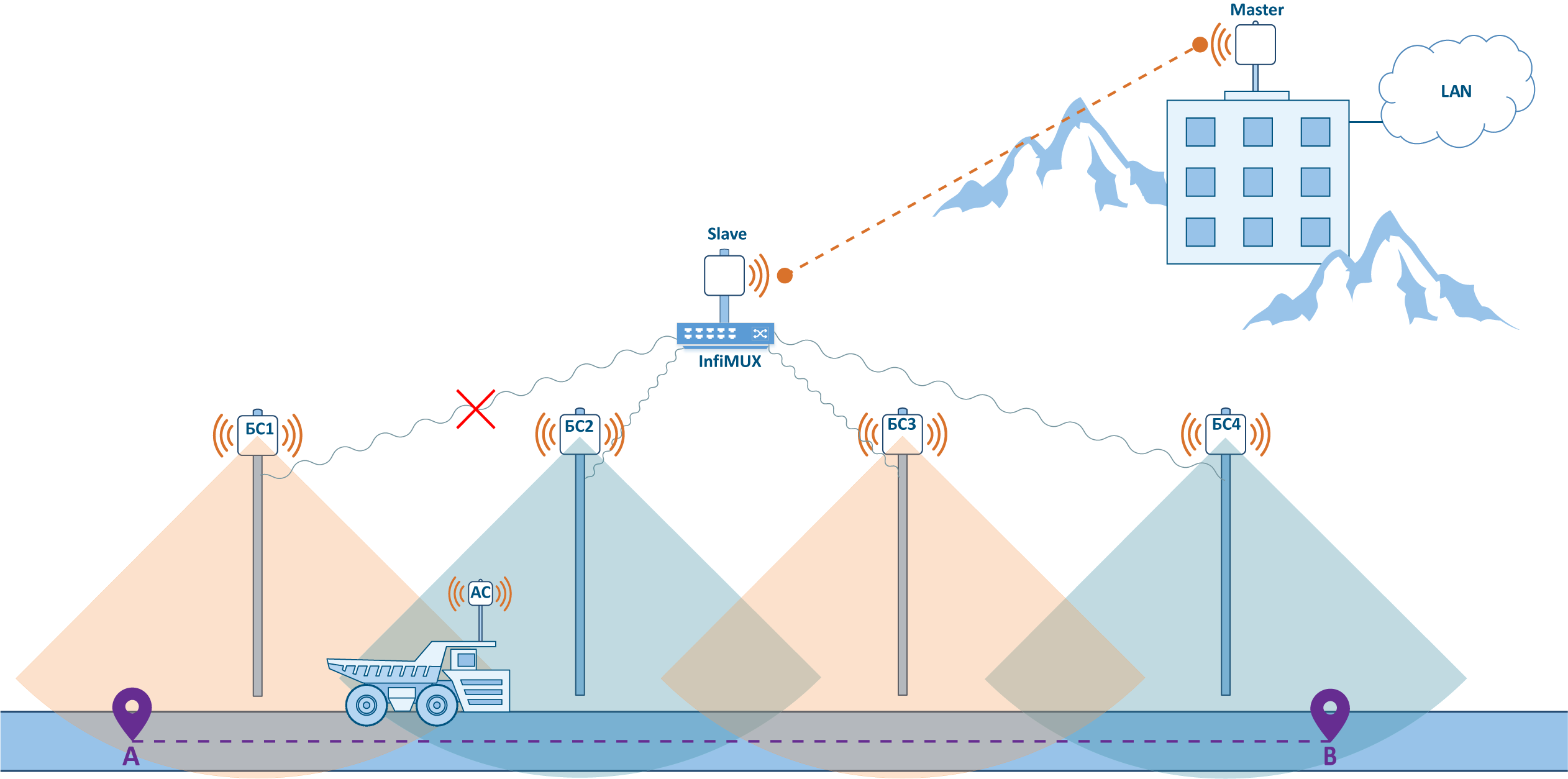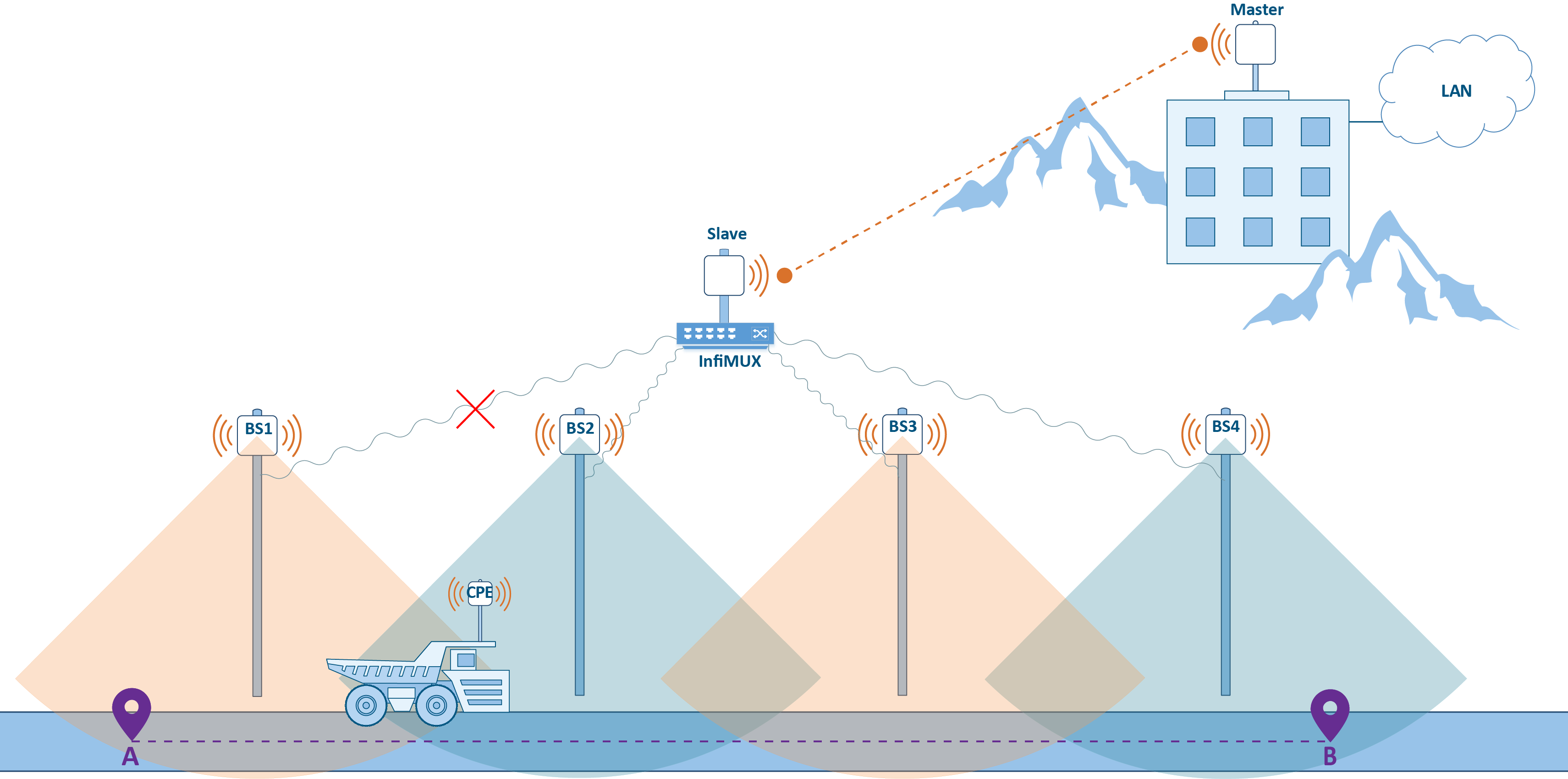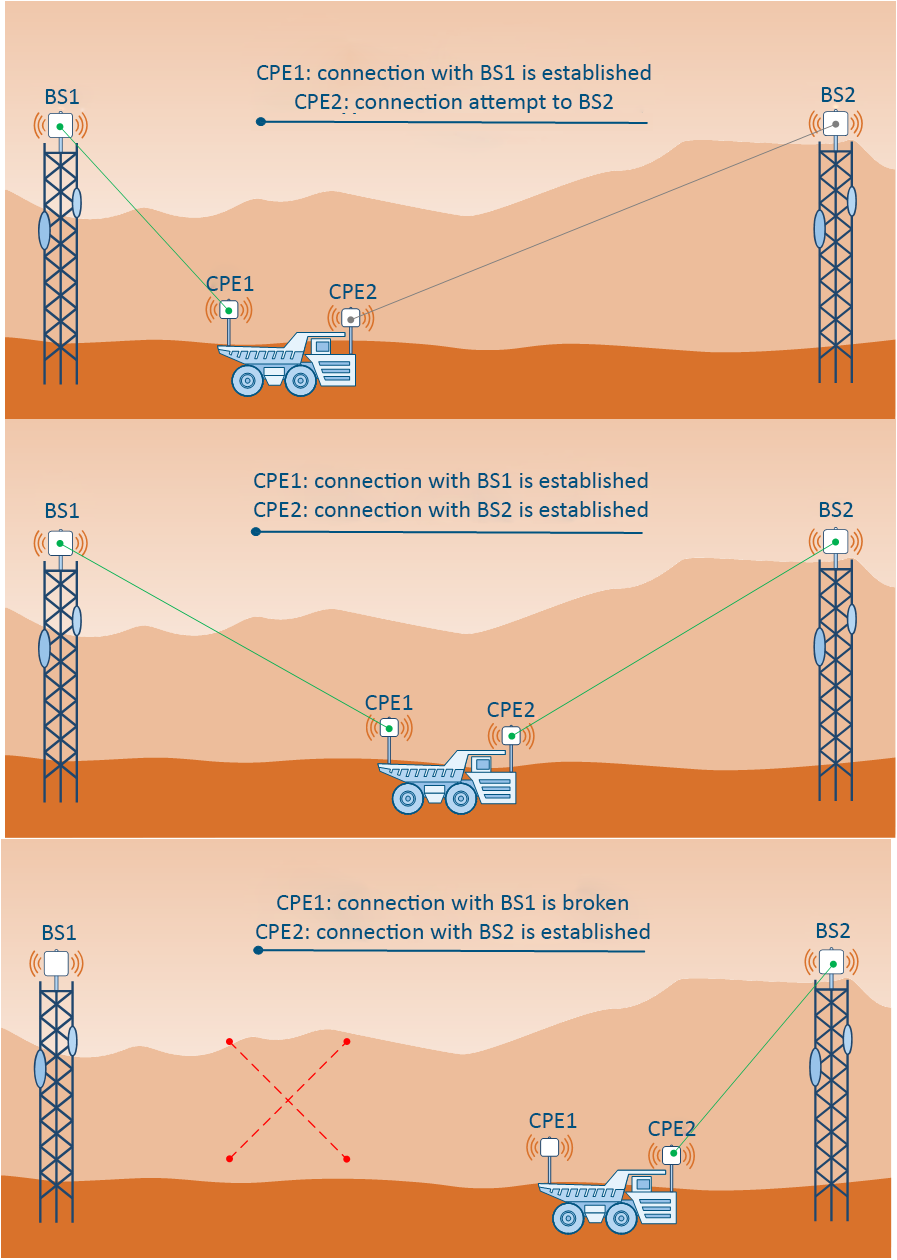| Include Page | ||||
|---|---|---|---|---|
|
| Note | |
|---|---|
This document contains sub-pages with examples:
|
Content
| Table of Contents | ||
|---|---|---|
|
Introduction
This document describes the ability of the InfiNet devices ability to provide sustainable wireless connectivity with mobile objects in various scenarios. There is a basic project presented genarally and the features of its implementation for the A basic deployment is generally presented along with the features related to its implementation for the mining industry, railway and water transport.
...
Basic requirements
Let's look at the basic scenario below (Figure 1), which involves the movement of one or more objects throughout the enterprise area along a given path between points A and B. The network control center is located at a certain distance from the area there where the moving object can be located.
The project goal is to organize a reliable wireless connectivity between the control center and the mobile objects in order to provide various information services, such as telemetry data gathering, video surveillance, telephony , etc.
| Center |
|---|
Figure 1 - Basic scenario for connectivity with mobile objects |
Two categories of tasks must be solved to achieve this goal:
- Network establishmentNetwork deployment including the following sections:
- A backbone backhaul radio network creation. The coverage of the backbone backhaul radio network should correspond to the object movement 's area of motion.
- An aggregation node creation. The aggregation node is designed to join the backbone to collect the traffic of the backhaul radio network devices and is it is a gateway between the radio network and the enterprise network.
- To establish a backbone A backbone link between the aggregation unit node and the control center.
- Fault tolerance and roaming providingcapabilities for:
- Ensuring the link fault tolerance at the access level (backhauling).
- Providing seamless subscriber roaming within the backbone backhaul radio network.
- Ensuring fault tolerance of the main link between the aggregation unit and node and the control center.
- Ensure the possibility of QoS policy implementationEnsuring the possibility of implementing QoS policies.
...
Solution
Network
...
deployment
The solution of the network establishing problems solution to the tasks described above is shown in Figure 2 . The solution can and it can be divided into four components:
- An enterprise network.
- An aggregation node.
- A backbone radio network.
- Object movement area.
...
- The backbone link towards the enterprise network
- The aggregation node
- A backhaul radio network
- The object's area of motion
The backhaul radio network consists of several base stations (BS) joined , joined by a wired infrastructure. Each BS can consist of one or several sectors , the and the combination of their antenna patterns forms the radio network coverage area. As CPEs and BS sectors, the The InfiMAN 2x2 family , InfiMAN Evolution families devices can be used as CPEs and BS sectors. Keep in mind that wireless links as well as combined infrastructure can be used to join several BSs.
The base stations are joined by joined at the aggregation node where the node where the InfiMUX switch device is installed. As shown below, the InfiMUX simplifies the configuration of InfiNet devices by adding all BSs configuration for the InfiNet devices by joining all the BSs into a single MINT area.
A backbone link is established between the aggregation node and the network control center. The choice of channel-forming devices is specific devices for the radio link is determined by the transmitted traffic capacity (see Performance of the InfiNet Infinet Wireless devices) the . The following throughput values can be achieved:
- InfiLINK 2x2 family devices: upto 280 up to 280 Mbps.
- InfiLINK XG family Evolution family devices: upto 500 up to 670 Mbps.InfiLINK XG 1000 family
- Quanta 5 and Quanta 6 families devices: upto 1000 Mbps.
...
- up to 650 Mbps.
- Quanta 70 family devices: up to 480 Mbps.
- InfiLINK XG family devices: up to 500 Mbps.
- InfiLINK XG 1000 family devices: up to 1000 Mbps.
A subscriber station (CPE) is installed on each mobile object , the and its configuration contains radio profiles for each BS sector in its area of motion. The operation operational principle is that the CPE can switch the connections while moving between BSthe base stations. Since the BS sectors provide coverage for the entire area in which the CPE can be located, the CPE is always in the coverage area of at least one BS. As soon as the radio parameters of the current connection deteriorate, the CPE breaks CPE interrupts the radio link and connect connects to another sector. So, while the object moving moves from point A to point B (Figure 2) the CPE is connecting one by one to the sectors of BS1, BS2, BS3 and BS4.
Keep in mind that the CPE cannot be simultaneously connected to two BSbase stations, because the device has one radio module, so CPE switching between the BSs is so the roaming between the base station sectors is accompanied by a short-term connectivity break. Several CPEs can be simultaneously connected to one BS sector.
| Center |
|---|
Figure 2 - Areas distributionDistribution of areas |
Fault tolerance and roaming
In addition to the infrastructure described earlier there is extended an extended list of tasksrequirements, which makes make the solution fault-tolerant and more efficient:
- The link fault tolerance at the access level is ensured by overlapping the sectors' radiation patterns on patterns at the backbone backhaul radio network designing design stage. So, if there is an overlap with neighboring sectors more than 50% overlapping with the neighboring sectors, a failure in one of the sector failure sectors will not affect the coverage area of the radio network. Radio frequency planning requires a complex approach and it is discussed in more detaily detail in the following sections.
- As noted, roaming in the proposed solution is not seamless, because CPE switching between different BS is because the roaming between different base stations is accompanied by a connectivity break. A seamless roaming requires an requires the installation of a second CPE device on each moving object. Such a solution is detaily described below.
- InfiNet devices can be used in various scenarios of point-to-point links link reservation and aggregation. For example, the backbone link can be reserved using the proprietary failover technology which requires an requires the installation of a second backup wireless devices setlink. Failover allows automatic reservation of the backbone link using only one frequency channel. Options The options for organizing link reservations reservation are presented in the Link aggregation, balancing and redundancy document.
An implementation The implementation of a QoS policy does not require the installation of additional devices installation and it is solved by configuring the wireless devices units and the InfiMUX configurationdevice:
- The telemetry gathering service, telephony and the remote control are sensitive to delay and jitter, so they require careful configuration of traffic distribution rules by classes. Low A low jitter for sensitive services can be achieved by using software versions with TDMA technology support on the InfiMAN 2x2 and InfiMAN Evolution devices. A comparative analysis of between the Polling and TDMA multiple access technologies is provided in the TDMA and Polling: Application features document.
- The video surveillance service, in addition to the delay requirements, requires the demands an increased throughput in the uplink (from the CPE to the BS). The InfiMAN 2x2 devices family supports and InfiMAN Evolution devices families support the time division multiple access method (TDMA), which allows an administrator flexibly allocate a flexible allocation of the available throughput between the upstream and downstream channels.
- Using a single infrastructure to provide a range of different services requires flexible allocation of available the available throughput between them..
| Anchor | ||||
|---|---|---|---|---|
|
Each the considered solution implementation is Each implemented solution is unique and requires careful preliminary planning. It is a very important stage, saving resources at the design stage can greatly increase operating the operational costs. Within this document, the radio frequency planning issues and devices placement will of the devices will be reviewed.
RF planning
Frequency planning is a complex, creative process that defines:
- Installation The installation coordinates.
- Suspension The suspension height, azimuth and antenna elevation.
- Devices partnumbersThe part numbers of the devices.
- Frequency The frequency channels and the transmission power.
The result of the frequency planning is a device allocation map with basic radio settings. A convenient tool for radio planning and potential performance assessment depending on the radio parameters is InfiPLANNER.
...
- Regulatory restrictions: RF regulation is determined at the legislative level. Usually, a frequency range it is allocated either a frequency range that is allowed for free use with certain restrictions(radiated power, antenna suspension height , etc.) , and or a frequency range for which the permission must be obtained.
- Radio module capabilities: the wireless device radio module supports radio module of the wireless devices supports a limited set of emitted emission frequencies , this and this should be taken into account at the designing design stage.
- Physical features of the electromagnetic waves propagation: propagation distance, the effect of precipitation and interaction with obstacles are determined by the electromagnetic wave frequency, which must be keep kept in mind during preliminary calculations. The radio waves propagation effects are detaily described are detailed in the Wireless Networking Fundamentals online course.
- The interference level: the operation of third-party wireless devices has a significant impact on the system's performance, take so it should be taken into account when designing the link. The interference level is affected by the radiation radiated power and the frequency channels used on thirdby the frequency channels used by the third-party devices operating in the areasame area. In addition to interference from third-party devices, the neighboring sectors can have influence on each other. Reducing interference from The reducing of the interference between your own devices can be achieved by using different frequency channels. Recommendations for frequency diversity are given in the TDMA and Polling: Application features document. Particular attention should be paid to the frequency channels channel selection in projects with multisectoral multisector configurations in order to minimize the influence of the BS sectors on each other.
The frequency distribution Some frequency allocation examples are presented below. Figure 3a illustrates a scheme there where each BS sector has it's own frequency channel. This approach requires the allocation of 4 frequency channels.
Let's look at the optimized scheme (Figure 3b). Since the sectors' position is chosen in such a way that the radiation patterns of BS1 and BS3, BS2 and BS4 do not intersect in pairs, they will not interfere with each other. This will optimize the frequency resource usedutilization, reducing the number of frequency channels from 4 to 2.
| Center |
|---|
a) |
| Center |
|---|
b) Figure 3 - The allocation of frequency channels between BS: a - using four channels, b - using two channels |
Device allocation
The device position in The position of the devices in space determines the actual quality indicators of the wireless link. The position of the device devices is determined by the:
- Installation coordinates.
- Azimuth and antenna elevation.
- Suspension height.
In projects with mobile objects, the antennas antenna's directional properties should be taken into account. If the BSs are static and the radio coverage area is constant, then the CPEs CPE's antenna radiation pattern can greatly affect the link quality. InfiNet's product portfolio includes devices with integrated antennas and the ability to connect external antennas , the device selection is determined by the project specificsas well. The selection of a specific device is determined by the specific requirements of the project.
The route profile must be evaluated along the entire trajectory of the object trajectory. This will allow to find potential "dead zones" there will be no connection , with no connectivity with the mobile object and . A decision to change the location of the BS if necessaryseveral base stations might be necessary in this case. In addition, perform a survey on enterprise the survey along the enterprise's territory, because the InfiPLANNER link planning tool does not take into account the effects of obstacles such as trees, buildings , etc.
The InfiNet product portfolio includes a wide range of accessories, including mounting kits that allow to install devices in various conditions with the possibility of flexible alignment , and the CAB-RV1 alignment tool which allows to perform preliminary device diagnostics.
The MINT protocol
Протокол канального уровня Ethernet разрабатывался для проводных сетей и в нём не учитывается специфика беспроводной среды. Производители беспроводных устройств могут использовать стандартные протоколы беспроводной передачи данных, например Wi-Fi, или использовать собственные разработки. Компания Инфинет развивает фирменный протокол передачи данных MINT, предназначенный для обмена данными в беспроводной средеThe Ethernet link layer protocol was developed for the wired networks and does not take into account the specifics of the wireless environment. Wireless device manufacturers can use standard wireless protocols, such as Wi-Fi, or use their self-developed protocols. InfiNet Wireless has developed a proprietary data transfer protocol called MINT, especially designed for data exchange in a wireless environment.
MINT (Mesh Interconnection Network Technolohy - технология построения сетей с произвольными связями) - фирменная технология компании "Инфинет", используемая в устройствах семейств InfiLINK 2x2 и InfiMAN 2x2, обеспечивающая передачу данных между устройствами по беспроводным и проводным каналам связи.
Понятие области MINT
Одним из центральных понятий протокола MINT является область MINT. Областью MINT называется множество устройств, являющихся соседями, т.е. обмен данными между которыми осуществляется с помощью кадров MINT (см. урок "Протокол MINT" онлайн-курса "Коммутация в устройствах семейств InfiLINK 2x2 и InfiMAN 2x2").
Рассмотрим описанное выше решение в контексте областей MINT (см. рисунок 4). Между устройствами Master и Slave установлен радиоканал и они образуют область MINT 5. Каждый из секторов БС1, БС2, БС3 и БС4 потенциально готов установить радиоканал с АС, установленной на подвижном объекте, образовав отдельную область MINT с соответствующим идентификатором.
| Center |
|---|
Рисунок 4 - Использование множества областей MINT в схеме организации связи с подвижными объектами |
Следует понимать, что протокол MINT предназначен для обмена данными в рамках области MINT. Данные вне области MINT могут быть переданы с помощью других канальных протоколов, например Ethernet, т.е. АС и каждый из секторов БС является шлюзом между MINT и Ethernet. В представленной схеме обмен данными осуществляется между подвижным объектом и центром управления, т.е. кадр в прямом и обратном направлениях пройдёт через несколько Ethernet-сегментов и областей MINT. Таким образом настройка коммутационных групп на каждом из устройств является обязательным условием передачи данных) - InfiNet's proprietary technology used by the InfiLINK 2x2, InfiMAN 2x2, InfiLINK Evolution and InfiMAN Evolution family devices, provides data transfer between devices via wireless and wired links.
MINT area
One of the MINT protocol's main concepts is the MINT area. A MINT area consist of many neighboring devices and data exchange between them is carried out using MINT frames (check the "MINT protocol" lesson of the InfiLINK 2x2 and InfiMAN 2x2: Switching online course).
Let's look at the solution described below, that implements the MINT areas concept (see Figure 4). A radio link is installed between the Master and Slave devices, they form MINT 5 area. Each of the BS1, BS2, BS3, and BS4 sectors is potentially ready to establish a radio link with the CPE installed on the mobile object and form a separate MINT area with the corresponding identifier.
| Center |
|---|
Figure 4 - Multiple MINT areas in the mobility scenario |
Note that the MINT protocol is intended for data exchange within the MINT area. Data outside the MINT area can be transmitted using other protocols, such as Ethernet, i.e. the CPEs and each of the base stations are the gateway between the MINT and Ethernet networks. In our scheme, data is exchanged between a mobile object and a control center, i.e. the frame will go through several Ethernet segments and MINT areas in the forward and backward directions. Thus, switch group configuration on each device is a prerequisite for data transfer:
| Code Block | ||||||
|---|---|---|---|---|---|---|
| ||||||
switch group 1 add eth0 rf5.0 switch group 1 start switch start |
Помимо инкапсуляции кадров Ethernet при их передаче через область MINT, протокол MINT подразумевает обмен служебными сообщениями для заполнения таблицы перенаправления кадров. Таблица перенаправления кадров позволяет выбирать маршрут передачи кадра (см. видеоролик 5) через область MINT в соответствии со значением стоимости, вычисляемой с учётом параметров радиоканала и его загрузки. Данный механизм гарантирует выбор оптимального маршрута с точки зрения радиопараметров и не допускает возникновения петельIn addition to encapsulating the Ethernet frames during the transmission through the MINT area, the MINT protocol performs an exchange of service messages to fill in the frame redirection table. The frame redirection table allows to select the frame transmission route (see video 5) through the MINT area in accordance with the radio parameters and the link load. This mechanism guarantees the selection of the route with the optimal radio parameters and prevents loops.
| Center | ||||||||
|---|---|---|---|---|---|---|---|---|
Видеоролик Video 1 - Пример выбора маршрута между узлами J и F в MINT |
...
An example of route selection between nodes J and F in MINT |
If necessary, you can influence the path selection algorithm by setting the link metric value manually. This can be done by summing the calculated and additional costs or by fixing a certain value (switching in Infinet devices is described in the online course InfiLINK 2x2 and InfiMAN 2x2: Switching)
| Code Block | ||||||
|---|---|---|---|---|---|---|
| ||||||
mint rf5.0 -extracost 1000 |
| Code Block | ||||||
|---|---|---|---|---|---|---|
| ||||||
mint rf5.0 -fixedcost 1000 |
Настройка и поддержка передачи данных и QoS на каждом из беспроводных устройств является трудоёмкой задачей, которую можно упростить, расширив область MINT. Ниже будут рассмотрены схемы, позволяющие снизить затраты на настройку и эксплуатацию беспроводных устройств за счёт объединения их в единую область MINTData transfer and QoS configuration on each wireless device is a time-consuming task that can be simplified by extending the MINT area. The schemes intended to simplify the configuration of the wireless devices by joining them into a single MINT area, are shown below.
| Anchor | ||||
|---|---|---|---|---|
|
...
Главным недостатком представленного выше решения является необходимость конфигурации коммутационных групп на всех беспроводных устройствах. Поскольку группа коммутации является шлюзом между MINT и Ethernet, то можно объединить все БС опорной радиосети в единую область MINT, закрепив функцию шлюза за коммутатором InfiMUX (см. рисунок 5). В этом случае группу коммутации необходимо будет настроить только на InfiMUX. Необходимость объединения устройств в единую область MINT и преимущества такой схемы рассматриваются в онлайн-курсе "Коммутация в устройствах семейств InfiLINK 2x2 и InfiMAN 2x2".
| Center |
|---|
Рисунок 5 - Объединение опорной радиосети в единую область MINT в схеме организации связи с подвижными объектами |
Использование протокола MINT в проводной инфраструктуре возможно с помощью псевдорадиоинтерфейса PRF. Это виртуальный интерфейс, являющийся дочерним для проводного интерфейса, выполняющий инкапсуляцию кадров MINT в кадры Ethernet. Настройка через CLI:
...
Joining sectors into one MINT area using InfiMUX
The main disadvantage of the solution above is the necessity to configure switch groups on all wireless devices. Since the switch group is a gateway between MINT and Ethernet, it is possible to combine all the BSs of the radio network into a single MINT area, transferring the gateway role to the InfiMUX switch (see Figure 5). In this case, a switch group has to be configured only on the InfiMUX. Joining devices into a single MINT area and the advantages of such a scheme are described in the InfiLINK 2x2 and InfiMAN 2x2: Switching online course.
| Center |
|---|
Figure 5 - Joining the backhaul radio network into a single MINT area |
Using the MINT protocol in a wired infrastructure is possible with the help of the PRF (pseudo radio) interface. It is a virtual interface that has a wired interface as parent and it encapsulates Ethernet frames into MINT frames. Configuration via CLI:
Create a PRF interface on a wireless device or on the InfiMUX:
Code Block language text theme Emacs title Создание Create PRF -интерфейсаinterface ifc prf0 mtu 1500 up prf 0 parent eth0 hwmtu 1514 mint prf0 start
Объединените Join RF - и PRF-интерфейсов на беспроводном устройствеand PRF interfaces on the wireless device:
Code Block language text theme Emacs title Объединение PRF- и RF-интерфейсовRF and PRF interfaces joining mint join rf5.0 prf0
Объединените двух PRF-интерфейсов на InfiMUXJoin two PRF interfaces on the InfiMUX:
Code Block language text theme Emacs title Объединение двух PRF-интерфейсовTwo PRF interfaces joining mint join prf0 prf1
К преимуществам такого решения можно отнести упрощение конфигурации QoS, т.к. правила обработки трафика разных классов обслуживания настраиваются только на InfiMUX.
Схема с объединением секторов и магистрального канала в одну MINT-область
В схеме с объединением устройств опорной радиосети в единую область MINT есть недостаток в части политики качества обслуживания: используемые правила классификации трафика должны быть продублированы на InfiMUX и устройствах магистрального канала связи Master и Slave. Если эти правила не продублировать, то эффект от внедрения политики QoS может значительно снизиться.
Одним из решений данной задачи является объединение каналообразующих устройств магистрали в единую область со всеми остальными устройствами (см. рисунок 6). Данное решение реализуемо только при использовании на магистральном канале связи устройств семейства InfiLINK 2x2. В этом случае единые правила классификации трафика, настроенные на Master, будут справедливы в рамках всей области MINT. Кроме того, функции шлюза между MINT и Ethernet могут быть перенесены на устройство Master, а вместо InfiMUX может быть использован любой коммутатор. Объединение областей выполняется по аналогии с рассмотренной выше конфигурацией.
| Center |
|---|
Рисунок 6 - Объединение всех беспроводных устройств в единую область MINT в схеме организации связи с подвижными объектами |
Роуминг
Перемещение подвижного объекта, на котором установлена АС, в рамках опорной радиосети сопровождается переходом из зоны обслуживания сектора одной БС в зону действия другого сектора этой же или другой БС. Процесс переключения АС между секторами БС называется роумингом. Роуминг сопровождается разрывом радиоканала с первым сектором и установлением радиоканала со вторымThe advantages of such a solution is the simplification of the QoS configuration, as traffic processing rules for different service classes are configured only on the InfiMUX.
Joining sectors and the backbone link into one MINT area
The disadvantage of the scheme having the backhaul radio network devices joined into a single MINT area is the quality of service policy that needs to be implemented at the backbone devices as well: the traffic classification rules must be duplicated on the InfiMUX and on the Master and Slave devices. If these rules are not duplicated, the effect of the QoS policy implementation can be significantly reduced.
One of the solutions is to combine the devices of the backbone link into a single area with all the other devices (see Figure 6). This solution is possible only when using InfiLINK 2x2 or InfiLINK Evolition families devices for the backbone link. In this case, the unified traffic classification rules configured on the Master device will be valid in the entire MINT area. In addition, the gateway functions between MINT and Ethernet can be transferred to the Master device, while any switch can be used instead of InfiMUX.
| Center |
|---|
Figure 6 - Joining all wireless devices into a single MINT area |
Roaming
The movement of the mobile object, with the CPE installed on top, within the access radio network is accompanied by a transition from the coverage area of one BS sector to another sector's coverage area of the same or of another BS. The transition process of the CPE between the BS sectors is called roaming. Roaming implies the disconnection of the radio link with the first sector and the connection establishment with the second sector.
| Anchor | ||||
|---|---|---|---|---|
|
...
Let's look at the roaming mechanism (see video 2):#min_max
- There is a radio link between the CPE and BS1.
- The vehicle moves and the radio link between CPE and BS1 becomes unavailable. The reason is the inability to maintain the communication due to insufficient signal power. As it is shown below, the initiator of the radio link disconnection can be either the CPE or the corresponding sector of BS1.
- The CPE is trying to reconnect to BS1. If successful, the algorithm returns to step 1; if not - to step 4.
- The CPE searches for devices to establish the radio connection.
- The CPE finds out BS2 and tries to establish a connection with it.
- The CPE establishes a radio link with BS2.
| Center | ||||||||
|---|---|---|---|---|---|---|---|---|
Видеоролик Video 2 - Механизм роуминга |
Установление радиоканала
Радиоканал может быть установлен между двумя устройствами при выполнении следующих требований:
- Хотя бы одному из устройств назначена роль "ведущий". Возможны связи "ведущий-ведущий", "ведущий-ведомый". Архитектура решения предусматривает настройку секторов БС, как ведущих, а АС - как ведомых.
- В конфигурации АС создан радиопрофиль, соответствующий настройкам радио на БС.
- Параметры сигналов (RSSI, SNR и т.д.) позволяют выполнять обмен данными хотя бы на минимальной модуляции.
Радиопрофили
На устройствах с ролью "ведущий" может быть настроен только один набор радиопараметров, который будет использоваться для организации каналов связи. На устройствах с ролью "ведомый" может быть создано несколько радиопрофилей, либо один с возможностью автоматического выбора частоты. Настройка через CLI:
...
Roaming mechanism |
Radio link establishment
A radio link can be established between two devices if the following requirements are met:
- At least one of the devices has a Master role. Possible connections: Master-Master, Master-Slave. The solution architecture implies the configuration of the BS sectors as Masters and of the CPEs as Slaves.
- A radio profile has been created in the CPE configuration, corresponding to the radio settings of the BS.
- The signal parameters (RSSI, SNR, etc.) allow the data exchange at least at the minimal modulation.
Radio profiles
On Master devices, only one set of radio parameters can be configured, which will be used to establish the links. On Slave devices, several radio profiles can be created, or only one, but with the ability to automatically select a frequency. Configuration via CLI:
Configure the radio parameters on the Master device:
Code Block language text theme Emacs title Настройка частоты на устройстве с ролью "ведущий"Frequency configuration on the Master rf rf5.0 band 20 rf rf5.0 mimo greenfield rf rf5.0 freq 5510 bitr 130000 sid 10101010 burst rf rf5.0 txpwr auto pwrctl distance auto
Создайте радиопрофиль на устройстве с ролью "ведомый" с фиксированным значением частотыCreate a radio profile on the Slave device with a fixed frequency value:
Code Block language text theme Emacs title Создание радиопрофиля с фиксированной частотойRadio profile with fixed frequency mint rf5.0 prof 1 -band 20 -freq 5510 -sid 10101010 \ -nodeid 60755 -type slave \ -autobitr -mimo greenfield
Создайте радиопрофиль на устройстве с ролью "ведомый" с автоматическим выбором частоты (если используется профиль с фиксированным значением частоты, то команда, приведённая ниже, не выполняетсяCreate a radio profile on the Slave device with automatic frequency selection (if a profile with a fixed frequency value is used, the command below will not be executed):
Code Block language text theme Emacs title Создание радиопрофиля с автовыбором частотыRadio profile with automatic frequency selection mint rf5.0 prof 1 -band 20 -freq auto -sid 10101010 \ -nodeid 60755 -type slave \ -autobitr -mimo greenfield
При попытке установить соединение, ведомое устройство циклично перебирает радиопрофили, добавленные в его конфигурацию. Как только один из профилей подходит для установки радиоканала, создаётся связь с ведущим устройством и перебор профилей прекращается. В случае, если в конфигурации создан профиль с автоматическим выбором частоты, ведомое устройство пытается установить соединение с ведущим, перебирая частоты, поддерживаемые радиомодулем. Список частот, перебираемый ведомым устройством может быть ограничен конфигурацией пользовательской частотной сетки.
Пример настройки пользовательской сетки частот через CLI (для интерфейса rf5.0 указывается диапазон частот от 5000 МГц до 5100 МГц с шагом 10 МГц, которые могут быть использованы в качестве центральной частоты канала при ширине канала 20 МГцWhen the Slave device tries to establish a connection, it cyclicaly looks over the radio profiles added to its configuration. As soon as one of the profiles becomes suitable for link establishment with the Master device, it initiates the connection and the profile search is stopped. In case that a profile with automatic frequency selection is used, the Slave device tries to establish a connection with the Master by searching through the frequencies supported by the radio module. The list of frequencies to search through may be limited by the configuration of the user frequency grid.
Example of a custom frequency grid configuration via CLI (for the rf5.0 interface, the frequency range from 5000 MHz to 5100 MHz with a step of 10 MHz is set, when using a channel width of 20 MHz):
| Code Block | ||||||
|---|---|---|---|---|---|---|
| ||||||
rf rf5.0 grid 20 5000-5100/10 |
Очевидно, что установка связи может оказаться длительной операцией при использовании режима автоматического выбора частоты на ведомом устройстве из-за широкого диапазона частот, поддерживаемых радиомодулем. В рассматриваемых сценариях с роумингом это неприемлемо, поэтому рекомендуется в конфигурации АС создавать отдельные радиопрофили для каждого из секторов БС опорной радиосети.
Динамический выбор частоты
Устройства с ролью "ведущий" по аналогии с "ведомым" поддерживают режим динамического выбора частот (DFS). Устройства с поддержкой DFS перед выбором частоты выполняют сканирование доступных частотных каналов, оценивают уровень интерференции и наличие радаров. Среди частотных каналов, свободных от радаров, выбирается канал с минимальным уровнем интерференции, который устанавливается в качестве рабочего.
DFS является стандартной технологией для беспроводных устройств, однако её недостаток состоит в том, что оценка радиообстановки выполняется только при включении и не актуализируется в процессе работы. Использование дополнительного радиомодуля на некоторых моделях устройств Инфинет позволяет реализовать фирменную технологию Instant DFS. Дополнительный радиомодуль постоянно сканирует эфир, выполняя переход между частотными каналами в соответствии с уровнем интерференции. Технологии DFS, Radar detection и Instant DFS подробно описаны в документе Динамический выбор частоты.
Настройка DFS через CLI:
...
Obviously, link establishing can be a longtime operation when the automatic frequency selection mode is used due to the wide range of frequencies supported by the radio module. It is unacceptable in scenarios with roaming, therefore, we recommend to create on the CPE separate radio profiles for each BS sector of the backhauling radio network.
Dynamic frequency selection
Master devices as well as Slave devices, support the dynamic frequency selection (DFS) mode. Before selecting a frequency, the devices with DFS support scan the available frequency range, evaluate the interference level and the presence of radar. The operational channel is selected among the channels free of radar, having a minimum interference level.
DFS is a standard technology for wireless devices, but the disadvantage is that the assessment of the radio environment is performed only in the beginning and no updates are performed during operation. Using an additional radio module, on some models of InfiNet devices, allows to implement the proprietary Instant DFS technology. An additional radio module constantly scans the air, performing a swap between frequency channels in accordance with the interference levels in real time. The DFS, Radar detection and Instant DFS technologies are described in the Dynamic Frequency Selection document.
DFS configuration via CLI:
Enable DFS on the Master device:
Code Block language text theme Emacs title Активация DFS enable dfs rf5.0 dfsonly dfs rf5.0 freq auto
Активируйте DFS и Radar detection на устройстве с ролью "ведущий"Enable DFS and Radar detection on the Master device:
Code Block language text theme Emacs title Активация DFS и and Radar detection enable dfs rf5.0 dfsradar dfs rf5.0 freq auto
Активируйте поддержку iDFS на устройствах с ролью "ведущий" и "ведомый"Enable the iDFS support on the Master and Slave devices:
Code Block language text theme Emacs title Активация iDFS enable mint rf5.0 -idfs
Частотный роуминг
Под частотным роумингом в этом документе понимается изменение рабочей частоты установленного радиоканала, т.е. смена рабочей частоты выполняется на обоих устройствах.
Работа механизма частотного роуминга тесно сопряжёна с функцией Instant DFS, поскольку, при обнаружении частотных каналов с меньшим уровнем интерференции, чем на текущем, сектор БС в режиме PtMP или ведущее устройство в режиме PtP должны выполнить смену рабочей частоты. При этом подключенные к ним устройства, также должны выполнить смену частотного канала. Поведение устройств при частотном роуминге определяется значением параметра "roaming":
- leader: устройство определяет новый частотный канал и рассылает служебные сообщения другим устройствам для смены рабочей частоты. Целесообразно данную функцию назначить на устройство с активированной функцией DFS/iDFS.
- enable: устройство, получив команду на смену рабочей частоты от "leader", выполняет переход на новый частотный канал.
- disable: устройство, получив команду на смену рабочей частоты от "leader", игнорирует её.
В рассматриваемом решении не используется технология DFS, однако в проектах, где необходимо использование DFS/iDFS, целесообразно настроить секторы БС как "roaming leader", а АС - как "roaming enable".
Настройка через CLI:
...
Frequency roaming
In this document frequency roaming represents a change in the operating frequency of the link, i.e. the frequency change is performed on both devices.
The frequency roaming mechanism operation is closely related to the Instant DFS function. When a frequency channel with a lower interference level is detected, the BS sector in PtMP mode or the Master in PtP mode must change the operating frequency. At the same time, the devices connected to them must also change the frequency channel. The behavior during frequency roaming is determined by the "roaming" parameter value:
- leader: the device sets a new frequency channel and sends service messages to other devices to change their operating frequency as well. We recommend to configure this function on a device with the DFS / iDFS function enabled.
- enable: the device, having received a command to change the operating frequency from the "leader", performs the transition to a new frequency channel.
- disable: the device, having received a command to change the operating frequency from the "leader", ignores it.
This solution does not use the DFS technology, however, in projects where the use of DFS / iDFS is necessary, it is advisable to configure the BS sectors as "roaming leader" and the CPEs as "roaming enable".
Configuration via CLI:
Enable roaming on the Master device:
Code Block language text theme Emacs title Конфигурация сектора БСBS sector configuration mint rf5.0 roaming leader
Активируйте роуминг на устройстве с ролью "ведомый"Enable roaming on the Slave device:
Code Block language text theme Emacs title Конфигурация АСCPE configuration mint rf5.0 roaming enable
Перезапустите интерфейс rf5.0 на устройствах с ролями "ведущий" и "ведомый":Restart the rf5.0 interface on both devices
Code Block language text theme Emacs title Конфигурация АС и БСBS and CPE configuration mint rf5.0 restart
Важно отметить, что ведомое устройство с Note that a Slave device with "roaming enable", получив команду на смену рабочей частоты от having received a command to change the operating frequency from the "roaming leader" выполнит переход в другой частотный канал даже в том случае, если в конфигурации ведомого устройства не будет соответствующего радиопрофиля. При этом, после перезагрузки, ведомое устройство не сможет установить радиоканал, т.к. будет руководствоваться набором радиопрофилей, добавленных в конфигурацию, will switch to another frequency channel even if there is no corresponding radio profile in the Slave device configuration. In this case, after a reboot, the slave will not be able to establish a link, because it will still be guided by the set of radio profiles added to the configuration.
| Anchor | ||||
|---|---|---|---|---|
|
...
The MultiBS
...
Главным недостатком механизма роуминга является то, что АС, после разрыва канала связи с БС1, пытается восстановить это соединение и, только после нескольких неудачных попыток, выполняет поиск других БС для установления радиоканала. Устройства Инфинет поддерживают фирменную функцию MultiBS, позволяющую ускорить этот процесс.
Механизм роуминга с функцией MultiBS представлен ниже (см. видеоролик 3):
...
function
The main disadvantage of the roaming mechanism: The CPE tries to keep the connection with BS1 until the signal is completely lost, and only then starts searching for other BSs to establish a new connection. Infinet devices support the proprietary MultiBS function, which speeds up this process.
The roaming mechanism with the MultiBS function is presented below (see video 3):
- The link is established between BS1 and the CPE.
- The vehicle moves and the radio link parameters between the CPE and BS1 deteriorate. The CPE interrupts the connection with BS1. Despite the fact that the radio link between the CPE and BS1 can be used to transmit data, the CPE notices a negative trend and preventively breaks the connection.
- The CPE searches for devices to establish a connection.
- The CPE senses one of the sectors on BS2 and tries to establish a link with this device.
- The CPE establishes a radio link with one of the BS2 sectors.
| Center | ||||||||
|---|---|---|---|---|---|---|---|---|
Видеоролик Video 3 - Механизм роуминга с функцией MultiBS |
...
Roaming mechanism with MultiBS function |
Run the following command to enable the MultiBS function:
| Code Block | ||||||
|---|---|---|---|---|---|---|
| ||||||
mint rf5.0 roaming enable multiBS |
Функция Global
Рассмотрим сценарий, в котором была повреждена кабельная трасса между InfiMUX и инжектором питания БС1 (см. рисунок 7), т.е. питание к БС1 подведено и устройство готово устанавливать радиосоединения, но передача данных в центр управления невозможна.
Автомобиль с установленным комплектом АС начинает движение по траектории из точки А в точку B. Находясь в зоне действия БС1, АС устанавливает с ней радиоканал. Поскольку кабельная трасса повреждена, то данные между подвижным объектом и центром управления не передаются. Двигаясь вдоль траектории, подвижный объект попадает в область, когда существует возможность подключиться к БС2, но параметры установленного канала связи с БС1 удовлетворительны и АС не выполняет роуминг между БС. Без настроенной функции MultiBS, АС будет поддерживать связь с сектором БС1 до момента выхода из зоны радиопокрытия сектора БС1.
Фирменная функция Global позволяет избежать подобной ситуации. В случае, если в конфигурации АС активирована функция Global, то АС будет устанавливать радиоканал только с устройствами, на которых тоже активна функция Global. Кроме того, устройства в одной области MINT могут выполнять проксирующую функцию по отношению к устройствам с активированной функцией Global. Таким образом, если в конфигурации InfiMUX и АС активировать функцию Global, то все БС в момент установления радиоканала будут сообщать АС о том, что через них доступен InfiMUX, у которого активирована функция Global. Если между БС1 и InfiMUX повреждена кабельная трасса, то БС1 не будет сообщать АС о доступности InfiMUX, т.е. АС не установит радиоканал с БС1.
Использование функции Global позволяет повысить отказоустойчивость опорной радиосети, однако её использование будет иметь эффект только при соответствующем радиочастотном планировании - области покрытия секторов должны быть выполнены с перекрытием.
| Center |
|---|
Рисунок 7 - Использование функции Global |
Настройка устройств через CLI:
...
The global function
Let's look at a scenario in which the wired connection between the InfiMUX and the power injector of BS1 is damaged (see Figure 7), i.e. power is supplied to BS1 and the device is ready to establish radio connections, but data can not be transmitted to the control center.
The vehicle with the CPE installed starts moving along the trajectory, from point A to point B. Being in the BS1 coverage area, the CPE establishes a radio link with it. Since the wired connection is damaged, no data is transmitted between the moving object and the control center. Moving along the trajectory, the mobile object gets in the area where it is possible to connect to BS2, but the connection parameters with BS1 are satisfactory and the CPE does not perform roaming between the BSs. Without the MultiBS function, the CPE will keep the connection with BS1 until it leaves its radio coverage area.
The "Global" proprietary feature avoids this situation. If the Global function is activated on the CPE, it will only establish a radio link with the devices on which the Global function is also enabled. In addition, devices in the same MINT area can perform a proxy function for devices with the Global function enabled. Thus, if the Global function is enabled on the InfiMUX and on the CPE, then all the BSs will inform the CPE that they have a connection with the InfiMUX with the Global function activated at the time the radio connection is established. If a wired connection is damaged between BS1 and the InfiMUX, BS1 will not inform the CPE about the availability of the InfiMUX, i.e. the CPE will not establish a radio link with BS1.
Using the Global function allows to increase the fault tolerance of the backhaul radio network, however, it will have a positive effect only with an appropriate radio frequency planning since the coverage areas of the sectors must overlap.
| Center |
|---|
Figure 7 - Global function usage |
Device configuration via CLI:
Enable the Global function on the CPE:
Code Block language text theme Emacs title Активация функции Global на АСGlobal function on CPE mint rf5.0 roaming enable global
Активируйте функцию Global на Enable the Global function on the InfiMUX:
Code Block language text theme Emacs title Активация функции Global на function on InfiMUX mint prf0 roaming enable global
| Anchor | ||||
|---|---|---|---|---|
|
...
Одним из механизмов, определяющим момент разрыва связи с одним сектором и установления связи с другим сектором, является оценка пороговых значений SNR. В конфигурации беспроводных устройств выделяют два пороговых значения:
- hiamp: минимальное значение SNR, требуемое для установления радиоканала между двумя устройствами.
- loamp: минимальное значение SNR, при котором радиоканал между устройствами не будет разорван.
Таким образом, настройка пороговых значений на БС или АС является одним из механизмов по управлению процессом роуминга АС.
...
Link establishment process control
One of the mechanisms to determine the moment of disconnection from one sector and the establishment of a connection with another, is the assessment of the SNR threshold values. Two thresholds are used in a wireless device configuration:
- hiamp: minimum SNR value required to establish a radio link between two devices.
- loamp: minimum SNR value at which the radio link between devices will not be broken.
Thus, the thresholds values' configuration on the BS or on the CPE is the mechanism for controlling the roaming process.
The SNR level configuration for establishing a radio link on wireless devices is performed using the following commands:
| Code Block | ||||||
|---|---|---|---|---|---|---|
| ||||||
mint rf5.0 -hiamp 2 |
| Code Block | ||||||
|---|---|---|---|---|---|---|
| ||||||
mint rf5.0 -loamp 0 |
...
Fixed/mobile/nomadic
...
Одним из факторов, влияющих на параметры канала связи с подвижным объектом, является степень актуальности таблицы перенаправления кадров MINT. Поскольку речь идёт о таблице перенаправления MINT, то данная настройка может быть применена только на устройствах семейств InfiLINK 2x2 и InfiMAN 2x2. В конфигурации устройств можно установить интервал обновления записей таблицы перенаправления MINT, выбрав одно из трёх значений параметра "mode":
- fixed: обновление таблицы перенаправления выполняется с интервалом 3 секунды. Данный режим предназначен для организации каналов связи со статичными объектами.
- nomadic: обновление таблицы перенаправления выполняется с интервалом 1,5 секунды. Данный режим предназначен для организации каналов связи с подвижными объектами малой скорости.
- mobile: обновление таблицы перенаправления выполняется с интервалом 1 секунда. Данный режим предназначен для организации каналов связи с подвижными объектами.
АС с активированной функцией MultiBS, как показано выше, выполняет сравнение текущих показателей радиоканала с максимально достигнутыми. Возможен сценарий, в котором параметры радиоканала резко ухудшатся из-за кратковременного влияния помехи и так же резко восстановятся. АС разорвёт связь с БС в соответствии с алгоритмом работы функции MultiBS, несмотря на то, что ухудшение параметров радиоканала носило кратковременный характер. Выбор значения параметра "mode" влияет на анализ радиопараметров при активированной функции MultiBS, задавая временной интервал оценки. Таким образом устройство со значением параметра "mode fixed" выполняет оценку радиопараметров на интервале трёх секунд и более устойчиво к разрыву радиоканала в условиях кратковременных помех, чем устройство со значением "mode mobile".
Установка значения параметра mode в конфигурации устройства может быть выполнена следующим образом:
...
modes
One of the factors affecting the link parameters for a moving object is the relevance of the MINT frame redirection table. The below configuration can only be applied on the InfiLINK 2x2, InfiMAN 2x2, InfiLINK Evolution and InfiMAN Evolution families devices. The device configuration allows to set the update interval for the MINT redirection table entries by choosing one of the three "mode" parameter values:
- fixed: the redirection table is updated at intervals of 3 seconds. This mode is intended for static (fixed) links.
- nomadic: the redirection table is updated at intervals of 1,5 seconds. This mode is intended for links connecting slowly moving objects.
- mobile: the redirection table is updated at intervals of 1 second. This mode is intended for connecting mobile objects.
As shown above, a CPE with the MultiBS function activated, compares the current radio link performance with the maximum achieved. There is a possible scenario in which the radio link parameters deteriorate sharply due to the short-term influence of the interference and also recovers sharply afterwards. The CPE will break the connection with the BS in accordance with the MultiBS algorithm, despite the fact that the radio link deterioration had a short-term occurrence. The “mode” parameter selection affects the radio parameters' analysis when the MultiBS function is enabled, by setting the evaluation time interval. Thus, a device in a fixed mode evaluates the radio parameters over a three seconds interval and it is more resistant to link disconnection under short-term interference, than a device in a mobile mode, that evaluates the parameters more often.
The "mode" parameter can be configured by using the following commands:
Set the fixed mode on the Master and Slave devices:
Code Block language text theme Emacs title Конфигурация режима fixedFixed mode configuration mint rf5.0 -mode fixed
Установите режим nomadic на устройствах с ролью "ведущий" и "ведомый"Set the nomadic mode on the Master and Slave devices:
Code Block language text theme Emacs title Конфигурация режима nomadicNomadic mode configuration mint rf5.0 -mode nomadic
Установите режим mobile на устройствах с ролью "ведущий" и "ведомый"Set the mobile mode on the Master and Slave devices:
Code Block language text theme Emacs title Конфигурация режима mobileMobile mode configuration mint rf5.0 -mode mobile
| Anchor | ||||
|---|---|---|---|---|
|
...
Активация функции MultiBS, как показано выше, ускоряет роуминг АС между БС, однако, в любом случае, роуминг сопровождается кратковременным перерывом связи. Избежать перерыва связи позволяет использование двух АС на подвижном объекте, объединённых с помощью InfiMUX. В этом случае каждая из АС будет независимо устанавливать радиоканал с БС, а InfiMUX будет принимать решение по выбору канала связи для пересылки данных.
Поясним алгоритм роуминга в схеме с двумя АС (см. рисунок 8):
- АС1 и АС2 установили радиоканал с БС1. При этом не возникает петли, т.к. все радиоустройства объединены в одну область MINT и устройства используют таблицу перенаправления кадров, учитывающую параметр стоимости.
- Автомобиль движется, АС2 разрывает канал связи с БС1. АС1 сохраняет связь с БС1. Перерыва сервиса не наблюдается, т.к. для обмена данными между автомобилем и центром управления осуществляется через канал АС1-БС1.
- АС2 начинает поиск БС для установления радиоканала. АС1 сохраняет канал связи с БС1.
- АС2 устанавливает связь с БС2. АС1 сохраняет связь с БС1. При передаче данных InfiMUX использует один из двух каналов связи АС1-БС1 и АС2-БС2, с меньшей метрикой.
- Автомобиль движется и АС1 разрывает связь с БС1. АС2 сохраняет связь с БС2. Передача данных будет выполнена через канал АС2-БС2, перерыва сервиса не наблюдается.
| Center |
|---|
Рисунок 8 - Роуминг в схеме с двумя АС на подвижном объекте |
Настройка устройств заключается в том, что на устройствах АС1 и АС2 должны быть созданы PRF-интерфейсы в сторону InfiMUX, а на InfiMUX - PRF-интерфейсы в сторону беспроводных устройств. Кроме того, настройка групп коммутации должна быть перенесена из конфигурации АС в конфигурации InfiMUX.
...
Seamless roaming
As shown above, the MultiBS function speeds up the CPE roaming between the BSs, however, roaming is still accompanied by a short break in the connection. Link interruption avoidance can be achieved by using two CPEs on the moving object, combined with the functionalities of the InfiMUX. In this case, each CPE will independently establish a radio link with the BS and the InfiMUX will route the data traffic by choosing one of those links.
Let's look at the roaming algorithm with two CPEs (see Figure 8):
- CPE1 and CPE2 have established links with the BS. In this case, no loop occurs because all radio devices are joined in one MINT area and the devices use a frame redirection table that takes into account the cost parameters.
- The vehicle is moving, CPE2 breaks the link with BS1. CPE1 keeps the connection with BS1. The service hasn't been interrupted, because the data exchange between the vehicle and the control center is carried out via the CPE1-BS1 link.
- CPE2 is looking for a BS to establish a radio link. CPE1 keeps the connection with BS1.
- CPE2 establishes connection with BS2. CPE1 keeps the connection with BS1. When transmitting data, the InfiMUX uses one of the two links CPE1-BS1 or CPE2-BS2, with a lower metric.
- The vehicle is moving, CPE1 breaks the link with BS1. CPE2 keeps the connection with BS2. The data transmission is performed via the CPE2-BS2 link and the service hasn't been interrupted.
| Center |
|---|
FIgure 8 - Roaming with two CPEs on a mobile object |
To perform the configuration, PRF interfaces should be created on the CPE1 and CPE2 devices towards the InfiMUX. PRF interfaces should also be created on the InfiMUX towards the wireless devices. In addition, the switch groups configuration must be performed on the InfiMUX, not on the CPEs.
Keep in mind that any changes in the configuration from the command line, should be saved. The command to save configuration:
| Code Block | ||||||
|---|---|---|---|---|---|---|
| ||||||
config save |
Дополнительные материалы
Онлайн-курсы
...
Additional materials
Online courses
- Wireless Networking Fundamentals.
- InfiPLANNER: Link Planning Tool.
- InfiLINK 2x2 and InfiMAN 2x2: Switching.
White papers
- Производительность устройств ИнфинетPerformance of the InfiNet Wireless devices.
- Агрегация каналов, балансировка и резервированиеLink aggregation, balancing and redundancy.
- TDMA и and Polling: особенности применения в беспроводных сетях.
- Динамический выбор частоты.
Вебинары
- Вебинар "Монтаж, грозозащита и заземление оборудования Инфинет".
- Вебинар "Типовые сценарии настройки коммутации на устройствах Инфинет".
- Вебинар "Переиспользование частот, синхронизация на устройствах Инфинет".
- Вебинар "1+1 с InfiNet Wireless: Резервирование и балансировка каналов связи".
Прочее
- Продукция Инфинет.
- Инструмент планирования беспроводных сетей Application features
- Dynamic Frequency Selection.
Webinars
- Infinet Wireless equipment installation, grounding and lightning protection.
- Switching configuration using Infinet Wireless devices - typical scenarios.
- Infinet Wireless PtMP network design with frequency reuse and SYNC.
